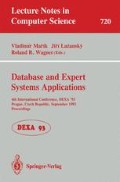Abstract
This paper gives an overview of a program visualisation system which allows users to build up agents to perform detection and inference about the symptomatic behaviours of their concurrent programs. The system allows users to graphically describe program behaviours and then to use these descriptions within a inference engine. Temporal relations are introduced between agents in order to allow the system to deal with concurrent behaviours. Finally we show how these can be combined with standard knowledge engineering techniques to debug programs, and how explanations can be graphically presented.
This work was supported by a MRC/SERC/ESRC UK Joint Research Council Grant #89/CS31, which is gratefully acknowledged.
Preview
Unable to display preview. Download preview PDF.
References
Allen, J.F. An Interval-Based Representation of Temporal Knowledge, in Proceedings of the Seventh International Joint Conference on Artificial Intelligence (IJCAI'81), pp. 221–226, Vancouver, B.C. Canada, 1981.
Brayshaw, M. An Architecture for Visualising the Execution of Parallel Logic Programming. Proceedings of the Twelfth International Joint Conference on Artificial Intelligence (IJCAI-91). Los Angeles: Morgan Kaufmann, 1991.
Brayshaw, M. Program Visualisation and Knowledge Negotiation, R. Moyse and M.T. Elsom-Cook (Eds.) Knowledge Negotiation, Academic Press:London, 1991.
Brayshaw, M. Visual Models of PARLOG Execution. Submitted for Publication, Submitted for Publication, Available as, Technical Report 64, Human Cognition Research Laboratory, The Open University, Milton Keynes, England.
Brayshaw, M. MRE: An Information Management Framework for Monitoring Program Execution, To appear in proceedings British Human-Computer Interface Conference, 1993.
Brayshaw, M. Seeing Parallel Logic Programs in Action, in prepn.
Brayshaw, M. and Eisenstadt, M. A Practical Graphical Prolog Tracer. International Journal of Man-Machine Studies., 55, pp. 597–631, 199.
Eisenstadt, M., Retrospective Zooming: a knowledge based tracing and debugging methodology for logic programming. Proceedings of the Ninth International Conference on Artificial Intelligence (IJCAI-85). Los Angeles: Morgan Kaufmann, 1985.
Eisenstadt, M. and Brayshaw, M. The Transparent Prolog Machine (TPM), Technical Report 21, Human Cognition Research Laboratory, The Open University, Milton Keynes, England.
Eisenstadt, M. and Brayshaw, M. Build your own Knowledge Engineering Toolkit BYTE: The Small Systems Journal), McGraw-Hill, Hightstown NJ, Part 1: October 1990, Part 2: November 1990a & b.
Eisenstadt, M., and Brayshaw, M. The Transparent Prolog Machine (TPM): an execution model and graphical debugger for logic programming. Journal of Logic Programming, 5(4),pp. 277–342, 1988.
Forgy, C. L. A Fast Algorithm for the Many Pattern/Many Object Pattern Matching Problem. Artificial Intelligence, 19:17–37, 1982.
Gregory, S. Parallel Logic Programming in PARLOG: The language and its implementation. Wokingham, UK: Addison-Wesley, 1987.
Key, A, User Interface: A Personnel View, In B. Laurel and S.J. Mountford (Eds.) The Art of Human-Computer Interface Design, page 191–208, Addison-Wesley, 1990
Kiss, G.R. Autonomous Agents, AI, and Chaos Theory. In J-A Meyer and S. Wilson, From Animals to Animats, Cambridge, Massachusetts:MIT Press, 1991.
TPM for Macintosh, Public Domain Software, c/o Human Cognition Research Laboratory, The Open University, Milton Keynes, England, 1991.
Author information
Authors and Affiliations
Editor information
Rights and permissions
Copyright information
© 1993 Springer-Verlag Berlin Heidelberg
About this paper
Cite this paper
Brayshaw, M. (1993). Intelligent inference for debugging concurrent systems. In: Mařík, V., Lažanský, J., Wagner, R.R. (eds) Database and Expert Systems Applications. DEXA 1993. Lecture Notes in Computer Science, vol 720. Springer, Berlin, Heidelberg. https://doi.org/10.1007/3-540-57234-1_45
Download citation
DOI: https://doi.org/10.1007/3-540-57234-1_45
Published:
Publisher Name: Springer, Berlin, Heidelberg
Print ISBN: 978-3-540-57234-3
Online ISBN: 978-3-540-47982-6
eBook Packages: Springer Book Archive

